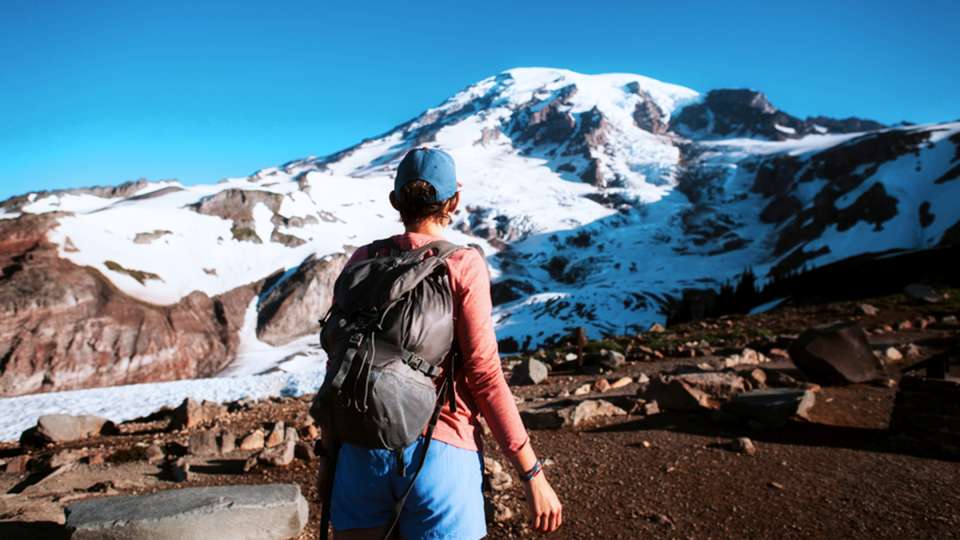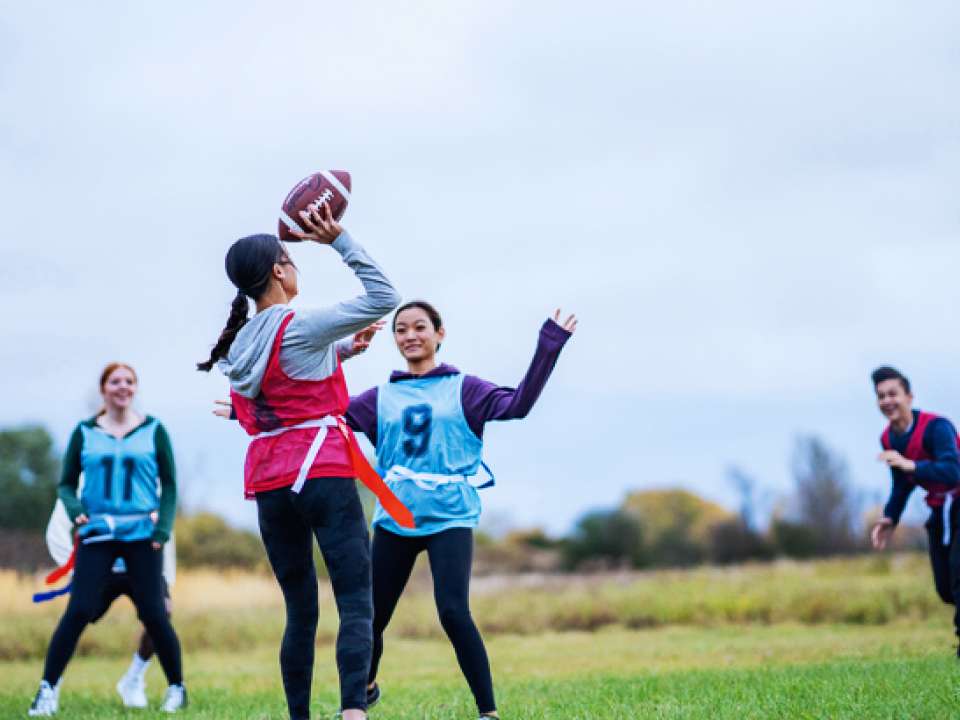
So you’re a hiker. You’ve been enjoying the many beautiful trails Washington state has to offer, but now you want to kick things up a notch.
Maybe you’re comfortable hiking Little Si and want to try Mount Si. Maybe your friend won a golden ticket (aka an Enchantments permit) and invited you on a thru-hike. Or perhaps you decided this is your year to hike up to Camp Muir.
Whatever your destination, you may be inclined (hiking pun) to just go for it, weekend-warrior style. And you might get away with it — or you might injure yourself.
“Think of hiking the same way we think of any other sport,” says Nika Cortese, a physical therapist at the Sports Medicine Center at Husky Stadium and an avid hiker herself. “You wouldn’t just not play much soccer and then play a 90-minute game or run occasionally and then run a marathon.”
Training helps prevent overuse injuries
You may be wondering: Why train for hikes? Why not just go for it?
Many of us can get away with this from time to time, Cortese says. But if you keep pushing yourself past your current fitness level — say, doing several hikes in a row that are harder than the ones you usually do — your body will protest.
This could mean you’ll feel wiped the next day, or you’ll be sore to a point that’s uncomfortable. You could even injure yourself.
“We see this with any sport involving endurance and repetitive motions, which are what cause overuse injuries such as tendonitis,” Cortese explains.
How hikers can reach peak performance
So, what is the best way for hikers to train? Here are Cortese’s top tips.
Identify your baseline fitness level
Before you start training, figure out your current fitness level. What can you do without feeling exhausted or sore the next day? What pushes you to your limits?
Factor in the hikes you already go on — and how often you go — as well as any other exercise you do, from walking or running to working out at the gym.
Once you understand how much you should push yourself and when not to, you’re better set up to build an effective training plan for yourself.
Focus on endurance
Cortese says that people tend to get frustrated if they’re trying to build both strength and speed on top of endurance and then aren’t meeting their goals quickly. This often happens because you’re trying to do too much at once.
Instead, she recommends focusing on building endurance first.
Think of it this way: If you can’t walk eight miles comfortably enough on a flat surface, you certainly won’t be able to walk eight miles on uneven terrain.
“Like with marathon training, if you’re going to do more mileage, you wouldn’t start training for that by sprinting: you need to build at a steady state. Once you build up comfort with distance, then you can work on building up speed and intensity of your hikes,” Cortese says.
When you’re figuring out how many miles you’re comfortable with, don’t discount the descent: It can be just as or more of a workout than the hike up. Many hiking injuries occur when people are coming down because they’re already tired from the hike and are working much harder to fight gravity.
Build out a gradual training program
First, figure out what your ultimate goal is. Do you want to be able to do all your favorite hikes and not get as tired? Do longer hikes? Go on a backpacking trip? Once you’ve set your goal, take steps to reach it.
Cortese recommends increasing your mileage by no more than 10% a week. So, if your usual hikes are around 4 miles roundtrip, find a hike that is 4.5 miles, then 5, then 5.5 and so on, making sure the elevation gain is relatively similar.
Meanwhile, keep doing your usual hikes. If you’ve primarily been hiking on weekends, try to find time to squeeze a hike in during the week. If that isn’t possible, substitute it for a long walk or some other form of exercise that will help you get in shape for your hiking goals.
Adding workouts that focus on building strength in your quads, glutes and calves, which are used a lot during hiking (especially going down) is also a good idea.
“There are tons of variations of squats, single-leg squats and step downs and ups that I use with patients who are looking to return to hiking,” Cortese says. “The key is working on exercises where we use one leg independent of the other.”
One-leg exercises mimic the motion of walking or stepping up as you’re hiking. If you tend to step up or pull yourself up higher primarily with one leg or one side of your body, it’s important to train the other side, too, as that is the side an overuse injury is more likely to occur on, Cortese says.
Keep past and current injuries in mind
If you’ve been injured in the past and are afraid of reactivating it or getting a new injury, the most important thing is to focus on how your body feels when you’re hiking, including knowing when to stop and when you can safely push yourself.
“Know your body and what you can do to keep old injuries quiet. For me, sometimes I get hip pain, but I can keep it quiet if I do a lot of hip activation and strengthening exercises,” Cortese says.
If you have a current injury or one from the not-too-distant past that still flares up occasionally, working with a physical therapist can help keep you hiking while preventing further injury and ensuring you’re still allowing your body to heal.
“One of my patient’s had a significant knee injury and trauma. She wants to hike all the time, and I know she’s going to go out and do it, so my goal is to move her forward without backsliding or having another injury. I set parameters for her, so she does 6 to 8 miles each hike but keeps elevation gain to 2,000 feet right now,” Cortese says.
Wear and use comfortable gear
If you’ve hiked the ever-popular Rattlesnake Ridge, you’ve probably seen a lot of people wearing less-than-ideal footwear (think sandals and Converse). While you can probably get away with it for a hike like that with a clear trail and not too much distance or elevation gain, most hikes will require better footwear.
“One thing everyone needs is a good pair of shoes for hiking, a pair that supports and fits your foot well and feels comfortable. You shouldn’t have foot pain or blisters when you get back,” Cortese says.
Ensure your pack also fits well and doesn’t cause any pain or discomfort. Local stores that specialize in outdoor recreation can help you find the best fit.
Microspikes (traction you can add to the bottom of your boots) in slippery conditions can help prevent slipping, while trekking poles can help take some of the pressure off your feet and legs.
Stretch when you’re done
“I educate my patients on the concept of 'undo what you just did,' meaning if you did a lot of activity, find ways to stretch those muscles after,” Cortese recommends.
This could be simple, like stretching at the trailhead after you’ve finished a hike and before you get in your car to head home. Once you get home, Cortese recommends using a foam roller.
The point is to cool down your body and help it recover, which reduces any potential soreness you’ll feel the next day — and helps you be ready for your next hike.

 Healthy ideas for your inbox
Healthy ideas for your inbox





